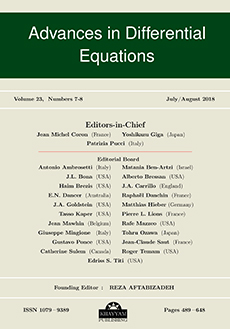Abstract
We consider a well-known model for micro-electromechanical systems (MEMS) with variable dielectric permittivity, involving a parabolic equation with singular nonlinearity. We study the touchdown, or quenching, phenomenon. Recently, the question whether or not touchdown can occur at zero points of the permittivity profile $f$, which had long remained open, was answered negatively for the case of interior points.
The first aim of this article is to go further by considering the same question at points of positive but small permittivity. We show that, in any bounded domain, touchdown cannot occur at an interior point where the permittivity profile is suitably small. We also obtain a similar result in the boundary case, under a smallness assumption on $f$ in a neighborhood of the boundary. This allows in particular to construct $f$ producing touchdown sets concentrated near any given sphere.
Our next aim is to obtain more information on the structure and properties of the touchdown set. In particular, we show that the touchdown set need not in general be localized near the maximum points of the permittivity profile $f$. In the radial case in a ball, we actually show the existence of “M”-shaped profiles $f$ for which the touchdown set is located far away from the maximum points of $f$ and we even obtain strictly convex $f$ for which touchdown occurs only at the unique minimum point of $f$. These results give analytical confirmation of some numerical simulations from the book [P. Esposito, N. Ghoussoub, Y. Guo, Mathematical analysis of partial differential equations modeling electrostatic MEMS, Courant Lecture Notes in Mathematics, 2010] and solve some of the open questions therein. They also show that some kind of smallness condition as above cannot be avoided in order to rule out touchdown at a point.
On the other hand, we construct profiles $f$ producing more complex behaviors: in any bounded domain the touchdown set may be concentrated near two arbitrarily given points, or two arbitrarily given $(n-1)$-dimensional spheres in a ball. These examples are obtained as a consequence of stability results for the touchdown time and touchdown set under small perturbations of the permittivity profile.
Citation
Carlos Esteve. Philippe Souplet. "No touchdown at points of small permittivity and nontrivial touchdown sets for the MEMS problem." Adv. Differential Equations 24 (7/8) 465 - 500, July/August 2019. https://doi.org/10.57262/ade/1556762456





